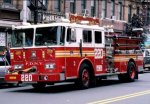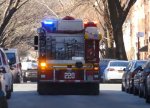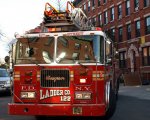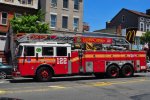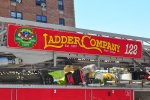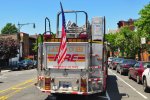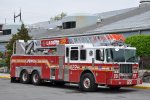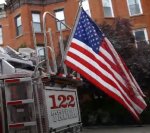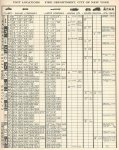You are using an out of date browser. It may not display this or other websites correctly.
You should upgrade or use an alternative browser.
You should upgrade or use an alternative browser.
FDNY and NYC Firehouses and Fire Companies - 2nd Section
- Thread starter mack
- Start date
- Joined
- Jan 16, 2009
- Messages
- 2,956
I
I just have one question regarding E 220 & L 122 quarters. I lived on 1st St bet 5 & 6 Ave in Park Slope back in the 50's & 60s....
Is there any reason as to why all the information regarding this firehouse is addressed as E 11 Street... Last time l was there it was on 11th St off 8th Ave and this was only a few months ago
ENGINE 220/LADDER 122 FIREHOUSES 530-532 EAST 11TH STREET, PARK SLOPE, BROOKLYN DIVISION 11, BATTALION 48 "PRIDE OF PARK SLOPE"
LADDER 122
View attachment 10057
View attachment 10058
View attachment 10059
I just have one question regarding E 220 & L 122 quarters. I lived on 1st St bet 5 & 6 Ave in Park Slope back in the 50's & 60s....
Is there any reason as to why all the information regarding this firehouse is addressed as E 11 Street... Last time l was there it was on 11th St off 8th Ave and this was only a few months ago
I just have one question regarding E 220 & L 122 quarters. I lived on 1st St bet 5 & 6 Ave in Park Slope back in the 50's & 60s....
Is there any reason as to why all the information regarding this firehouse is addressed as E 11 Street... Last time l was there it was on 11th St off 8th Ave and this was only a few months ago
Doug - You are right. Address should be 11th Street. My error. Thanks for the correction.

ENGINE 220/LADDER 122 FIREHOUSES 530-532 11TH STREET, PARK SLOPE, BROOKLYN DIVISION 11, BATTALION 48 "PRIDE OF PARK SLOPE"

Building of the Day: 530-532 11th Street

Photo: Christopher D. Brazee for Landmarks Preservation Commission
Architecture
Park Slope
Jun 21, 2013
Name: FDNY Ladder Co. 122/Engine Co. 220
Address: 530-532 11th Street
Cross Streets: 7th and 8th Avenues
Neighborhood: Park Slope
Year Built: (530) 1883, (532) 1906
Architectural Style: (530) Collegiate Gothic, (532) Beaux-Arts
Architect: (530) Frank. D. Norris, (532) Walter Parfitt
Other Work by Architect: Walter Parfitt (Parfitt Brothers), Engine 252, Bushwick, St. Augustine’s RC Church, Grace Methodist, both Park Slope. Also Montague, Grosvenor, Berkeley Apt Bldgs, Bklyn Hts, Hoagland mansion, Clinton Hill and Truslow House, Crown Heights North.
Landmarked: Yes, part of Park Slope HD Extension (2012)
The story: These two fire department buildings are rare examples of an old and newer firehouse buildings still standing next to each other. They provide a great architectural contrast, showing in the space of only twenty-three years, how much architecture and the community can change. The first fire house in this neighborhood was here, in 1882. At the time, this part of Park Slope was still developing, with a scattering of houses, most wood framed, with open lots between. The Ansonia Clock factory was already here, and about a year old in their new factory, and as they grew, so did the surrounding neighborhood.
The city authorized the building of a new building for a very necessary firehouse, and somehow Frank D. Norris got the job. Today, he is virtually unknown, but for this firehouse. This is too bad, because it’s really nice. Norris designed it in the Gothic Collegiate style, an architectural style usually reserved for school and civic buildings. The second floor windows with their arched lintels are especially attractive. The Gothic styling is certainly there, but it harkens back to the simpler early Gothic Revival style of the 1840s, not the ornate, ecclesiastical Gothic Revival style that was all the rage later. This ladder company building is quite small, and was not heavily manned, going to show that the neighborhood was not at the point where the city expected much to happen, disaster-wise.
By 1906, when the Parfitt building was complete, this part of Brooklyn had grown tremendously. Row upon row of brownstone and limestone row houses lined every side street, and the commercial strip along 7th Avenue was humming with small businesses. Architectural styles had changed too, and now, civic buildings like firehouses were expected to be formal and monumental, reflecting the City Beautiful philosophy that said that people should be impressed and inspired by a city’s fine architecture. The Beaux-Arts style, ornate and very European, was a perfect architectural venue for this philosophy. The Engine Company building is a fine example of this, with an extra story, high ceilings and rich looking limestone façade with an intricately carved parapet wall.
Neighborhood fire houses are either ladder or engine companies. A ladder truck enables the firefighters to climb up to rooftops and high windows to fight the fire and to facilitate rescues. These trucks are more complicated and costly than the engine trucks, which use hoses to pump the water from the fire hydrant or other source, through to the attached hoses, onto the fire. Both are needed in most situations. Both firehouses were landmarked in 2012, but in 2011, Mayor Bloomberg put Engine 220 on the list to be closed. There was much community protest for this house, and all of the rest on the list. In my opinion, fire houses should not be closed. It makes no sense, when they are already spread so thinly throughout the city. Disasters and tragedies don’t care about budgets. To my knowledge, it is still open.
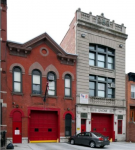
https://www.brownstoner.com/architecture/building-of-the-day-530-532-11th-street/
Building of the Day: 530-532 11th Street

Photo: Christopher D. Brazee for Landmarks Preservation Commission
Architecture
Park Slope
Jun 21, 2013
Name: FDNY Ladder Co. 122/Engine Co. 220
Address: 530-532 11th Street
Cross Streets: 7th and 8th Avenues
Neighborhood: Park Slope
Year Built: (530) 1883, (532) 1906
Architectural Style: (530) Collegiate Gothic, (532) Beaux-Arts
Architect: (530) Frank. D. Norris, (532) Walter Parfitt
Other Work by Architect: Walter Parfitt (Parfitt Brothers), Engine 252, Bushwick, St. Augustine’s RC Church, Grace Methodist, both Park Slope. Also Montague, Grosvenor, Berkeley Apt Bldgs, Bklyn Hts, Hoagland mansion, Clinton Hill and Truslow House, Crown Heights North.
Landmarked: Yes, part of Park Slope HD Extension (2012)
The story: These two fire department buildings are rare examples of an old and newer firehouse buildings still standing next to each other. They provide a great architectural contrast, showing in the space of only twenty-three years, how much architecture and the community can change. The first fire house in this neighborhood was here, in 1882. At the time, this part of Park Slope was still developing, with a scattering of houses, most wood framed, with open lots between. The Ansonia Clock factory was already here, and about a year old in their new factory, and as they grew, so did the surrounding neighborhood.
The city authorized the building of a new building for a very necessary firehouse, and somehow Frank D. Norris got the job. Today, he is virtually unknown, but for this firehouse. This is too bad, because it’s really nice. Norris designed it in the Gothic Collegiate style, an architectural style usually reserved for school and civic buildings. The second floor windows with their arched lintels are especially attractive. The Gothic styling is certainly there, but it harkens back to the simpler early Gothic Revival style of the 1840s, not the ornate, ecclesiastical Gothic Revival style that was all the rage later. This ladder company building is quite small, and was not heavily manned, going to show that the neighborhood was not at the point where the city expected much to happen, disaster-wise.
By 1906, when the Parfitt building was complete, this part of Brooklyn had grown tremendously. Row upon row of brownstone and limestone row houses lined every side street, and the commercial strip along 7th Avenue was humming with small businesses. Architectural styles had changed too, and now, civic buildings like firehouses were expected to be formal and monumental, reflecting the City Beautiful philosophy that said that people should be impressed and inspired by a city’s fine architecture. The Beaux-Arts style, ornate and very European, was a perfect architectural venue for this philosophy. The Engine Company building is a fine example of this, with an extra story, high ceilings and rich looking limestone façade with an intricately carved parapet wall.
Neighborhood fire houses are either ladder or engine companies. A ladder truck enables the firefighters to climb up to rooftops and high windows to fight the fire and to facilitate rescues. These trucks are more complicated and costly than the engine trucks, which use hoses to pump the water from the fire hydrant or other source, through to the attached hoses, onto the fire. Both are needed in most situations. Both firehouses were landmarked in 2012, but in 2011, Mayor Bloomberg put Engine 220 on the list to be closed. There was much community protest for this house, and all of the rest on the list. In my opinion, fire houses should not be closed. It makes no sense, when they are already spread so thinly throughout the city. Disasters and tragedies don’t care about budgets. To my knowledge, it is still open.

https://www.brownstoner.com/architecture/building-of-the-day-530-532-11th-street/
ENGINE 220/LADDER 122 FIREHOUSES 530-532 11TH STREET, PARK SLOPE, BROOKLYN DIVISION 11, BATTALION 48 "PRIDE OF PARK SLOPE"
ENGINE 220 MEDAL
JOHN S. LANGAN FF. ENG. 220 MAR. 4, 1909 1911 BROOKLYN CITIZENS
FF Langan was awarded the Brooklyn Citizens Medal in 1911 for heroic rescue efforts on March 4, 1909 at an apartment fire at 313 7th Avenue, Brooklyn.

FIRE BUILDING 313 7TH AVENUE
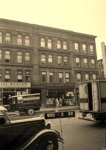
MEDAL DAY 1911
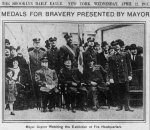
ENGINE 220 MEDAL
JOHN S. LANGAN FF. ENG. 220 MAR. 4, 1909 1911 BROOKLYN CITIZENS
FF Langan was awarded the Brooklyn Citizens Medal in 1911 for heroic rescue efforts on March 4, 1909 at an apartment fire at 313 7th Avenue, Brooklyn.

FIRE BUILDING 313 7TH AVENUE

MEDAL DAY 1911

ENGINE 220/LADDER 122 FIREHOUSES 530-532 11TH STREET, PARK SLOPE, BROOKLYN DIVISION 11, BATTALION 48 "PRIDE OF PARK SLOPE"
LADDER 122 MEDAL
WILLIAM WARD CAPT. LAD. 122 1920 1921 STEPHENSON
Capt. Ward received the Stephenson Medal for general discipline and all around fire duty. Ladder 122 was the outstanding FDNY fire company in 1920.
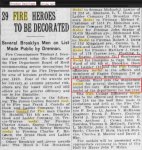
LADDER 122 MEDAL
WILLIAM WARD CAPT. LAD. 122 1920 1921 STEPHENSON
Capt. Ward received the Stephenson Medal for general discipline and all around fire duty. Ladder 122 was the outstanding FDNY fire company in 1920.

- Joined
- Sep 25, 2013
- Messages
- 996
Battalion 38 covers the Crown Heights neighborhood of Brooklyn. It has been the 8th District Engineer of the Brooklyn Fire Department, the 8th Battalion of Brooklyn FDNY, the original 28th Battalion, and the present 38th Battalion.
Brooklyn FD
Brooklyn FDNY
FDNY
Brooklyn FD
| District Engineer 8 | Organized | 231 Herkimer St, Brooklyn | 1885 | with Brooklyn FD Engine 14 | |
| District Engineer 8 | Annexed | as Battalion 8 FDNY Brooklyn | 1898 |
Brooklyn FDNY
| Battalion 8 | Organized | 231 Herkimer St, Brooklyn | 1898 | with Engine 14 FDNY Brooklyn | |
| Battalion 8 | Renumbered | as Battalion 28 | 1898 |
FDNY
| Battalion 28 | Organized | 231 Herkimer St, Brooklyn | 1898 | with Engine 14 Brooklyn | |
| Battalion 28 | Renumbered | as Battalion 38 | 1906 |
| Battalion 38 | Reorganized | 231 Herkimer St, Brooklyn | 1906 | with Engine 114 | |
| Battalion 38 | Relocated | 1472 Bergen St, Brooklyn | 1948 | with Engine 234 | |
| Battalion 38 | Relocated | 1352 Saint Johns Pl, Brooklyn | 1977 | with Ladder 123 |
Last edited:
- Joined
- Sep 25, 2013
- Messages
- 996
Battalion 38 covers the Crown Heights neighborhood of Brooklyn. It has been the 8th District Engineer of the Brooklyn Fire Department, the 8th Battalion of Brooklyn FDNY, the original 28th Battalion, and the present 38th Battalion.
Brooklyn FD
District Engineer 8 Organized 231 Herkimer St, Brooklyn 1885 with Brooklyn FD Engine 14 District Engineer 8 Annexed as Battalion 8 FDNY Brooklyn 1898
Brooklyn FDNY
Battalion 8 Organized 231 Herkimer St, Brooklyn 1898 with Engine 14 FDNY Brooklyn Battalion 8 Renumbered as Battalion 28 1898
FDNY
Battalion 28 Organized 231 Herkimer St, Brooklyn 1898 with Engine 14 Brooklyn Battalion 28 Renumbered as Battalion 38 1906
Battalion 38 Reorganized 231 Herkimer St, Brooklyn 1906 with Engine 114 Battalion 38 Relocated 1472 Bergen St, Brooklyn 1948 with Engine 234 Battalion 38 Relocated 1352 Saint Johns Pl, Brooklyn 1977 with Ladder 123
Brooklyn FD
| 1885 - 1886 | District Engineer 8 | E14 | E19 | E22 | ||||||
| 1886 - 1889 | District Engineer 8 | E14 | E19 | E22 | E25 | L7 | ||||
| 1889 - 1891 | District Engineer 8 | E14 | E19 | E22 | E25 | E27 | L7 | |||
| 1891 - 1892 | District Engineer 8 | E14 | E25 | E27 | L7 | |||||
| 1892 - 1893 | District Engineer 8 | E14 | E19 | L5 | L11 | |||||
| 1893 - 1895 | District Engineer 8 | E14 | E19 | E34 | L5 | L11 | ||||
| 1895 - 1896 | District Engineer 8 | E14 | E19 | E34 | E35 | L5 | L11 | |||
| 1896 - 1897 | District Engineer 8 | E14 | E19 | E27 | E34 | E35 | L11 | |||
| 1897 - 1898 | District Engineer 8 | E14 | E19 | E34 | E35 | L11 |
FDNY
| 1898 - 1900 | Battalion 28 | E14 | E19 | E35 | L11 | |||||
| 1900 - 1901 | Battalion 28 | E114 | E119 | E135 | L61 | |||||
| 1901 - 1902 | Battalion 28 | E114 | E117 | E122 | E134 | E135 | L61 | |||
| 1902 - 1906 | Battalion 28 | E114 | E119 | E135 | L61 |
| 1906 - 1909 | Battalion 38 | E114 | E119 | E135 | L61 | ||||||||
| 1909 - 1913 | Battalion 38 | E114 | E134 | E135 | L61 | ||||||||
| 1913 - 1922 | Battalion 38 | E214 | E235 | E280 | L111 | L132 | |||||||
| 1922 - 1930 | Battalion 38 | E214 | E219 | E235 | E280 | L111 | L132 | ||||||
| 1930 - 1951 | Battalion 38 | E214 | E219 | E234 | E235 | E280 | L111 | L132 | |||||
| 1951 - 1969 | Battalion 38 | E219 | E227 | E234 | E280 | L123 | L132 | ||||||
| 1969 - 1979 | Battalion 38 | E234 | E249 | E280 | L113 | L132 | |||||||
| 1979 - 1985 | Battalion 38 | E234 | E249 | E280 | L113 | L123 | L132 | ||||||
| 1985 - 1987 | Battalion 38 | E234 | E249 | E280 | L113 | L123 | L132 | R2 | |||||
| 1987 - 1988 | Battalion 38 | E234 | E249 | E280 | L113 | L123 | L132 | ||||||
| 1988 - 1995 | Battalion 38 | E234 | E249 | E280 | L113 | L123 | L132 | R2 | |||||
| 1995 - 2005 | Battalion 38 | E234 | E249 | E280 | L113 | L123 | L132 | ||||||
| 2005 - | Battalion 38 | E234 | E249 | E280 | L113 | L123 | L132 | R2* |
Last edited:
- Joined
- Sep 25, 2013
- Messages
- 996
Thank you for clarifying. Where does Haz Mat belong administratively?Since the formation of the Rescue BN the 38 has no administrative responsibility with R*2.

